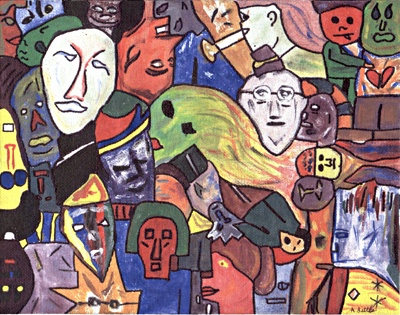All Nonfiction
- Bullying
- Books
- Academic
- Author Interviews
- Celebrity interviews
- College Articles
- College Essays
- Educator of the Year
- Heroes
- Interviews
- Memoir
- Personal Experience
- Sports
- Travel & Culture
All Opinions
- Bullying
- Current Events / Politics
- Discrimination
- Drugs / Alcohol / Smoking
- Entertainment / Celebrities
- Environment
- Love / Relationships
- Movies / Music / TV
- Pop Culture / Trends
- School / College
- Social Issues / Civics
- Spirituality / Religion
- Sports / Hobbies
All Hot Topics
- Bullying
- Community Service
- Environment
- Health
- Letters to the Editor
- Pride & Prejudice
- What Matters
- Back
Summer Guide
- Program Links
- Program Reviews
- Back
College Guide
- College Links
- College Reviews
- College Essays
- College Articles
- Back
What I Saw from Them
I glance at my watch. It’s now 9:37: no one has arrived to Prospect Park yet. In an hour, the area will be buzzing with fifty kids sprinting across the field in my direction. When I show the elementary students the mixture I’ve made with cornstarch and water, they are hypnotized by the tactile sensation of this non-Newtonian gooey mixture, which compacts into a solid when squeezed together and returns back to its liquid state after release. Off to the side, I see Ali standing alone, staring at the sight of kids giggling together. I grab his hand and invited him to come over, but he seems afraid of talking with others.
Every week I volunteer with the Pittsburgh Refugee Ministry; the opportunity to work with these kids is one of the reasons I look forward to my Saturdays. These students come from families who arrived to seek refuge in the United States. A majority are Bhutanese-Nepali, but it is not unusual to see families from Liberia, Somalia, and Burundi. Although most of the children from different backgrounds get along well with each other, a few such as Ali seem to lose social connection with other students. Imagine the greater difficulties for adults; without external assistance, integration of socially isolated immigrants into society is a difficult matter. As an immigrant myself from Korea, I felt a certain sense of responsibility to take action. I identify with these children and their unique odysseys and stories.
Although there were already activities for crafts, bible review, and outdoor games, I hoped to implement another tactic. I wished to share my diverse interests with hopes of spurring similar passion for learning among these students. My particular fascination with cognitive neuroscience began when I learned about the Invisible Gorilla Experiment. In this experiment, viewers count basketball passes on a video while a chest-thumping gorilla enters the middle of the game for nine seconds. Fifty percent of the viewers do not notice the gorilla because their attention was selectively placed on counting the number of basketball passes. I was also one of that fifty percent who experienced “inattentional blindness.” This has taught me an important lesson: it's very easy to miss the unexpected. So I wanted to be more mindful of the students. In real life, the gorilla may be their hidden talents and curiosities.
At 11:00 AM, I introduce students to the cornstarch mixture, describing the starch grain as suspended and spread out over the water. I ask them to compare the mixture’s reactions when they bang the surface with a spoon versus when they slowly grab a handful of goo. They actively ask questions and pondered answers. I am touched by their enthusiasm.
The rest of the kids run over to see for themselves. They experiment, play together, and later wipe each other’s hands with Kleenexes. Even in a simple experiment, I realize the power of teaching to bring out motivation and collaboration.
With a succinct explanation about the scientific process behind this phenomenon, I continue to introduce questions so that the students would be able to grasp the connection between the experiment and their daily interactions with others. The starch grain particles are “independent” like ourselves. They do not dissolve to become completely uniform with the solution. In society, everyone has his or her own uniqueness; however, it is impossible to function without communicating and cooperating with others. I want to relay a message to the students that adapting to a new environment does not involve changing who they are.
Now that ten years have passed since I moved to the US, I see many similarities between my hometown in Korea and my neighborhood in Pittsburgh. I have always been surrounded by people who offered encouragement and support towards my goals. Now I’ve realized. It’s my turn to help create an environment to let others know there is always support when they reach out.

Similar Articles
JOIN THE DISCUSSION
This article has 0 comments.

This piece is mainly about how I saw aspects of myself reflected through the children I interact with, as well as how my experience with them provided further insights and changes in perspectives about community and my role.